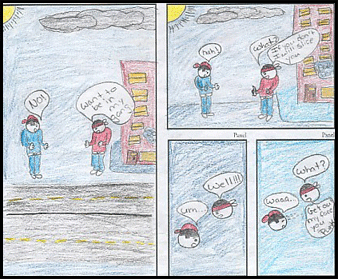
 |
|
Two days a week, in a converted science classroom, Rachel Beck supervises another after-school program at M.S. 302 in the Bronx. Even though the children’s art and decorations do not completely hide the Bunson burners and sink faucets, the 26-year-old art teacher said the creativity displayed by her students in the Comic Book Project is inspiring. “More schools should adopt it. A lot of times, kids are learning things that they don’t relate to at all. It’s really hard, especially in a school like this,” said Beck. “If they’re not interested in something, it’s going to be so hard for them to learn. If they can learn about reading, writing, spelling and things like that through comics, I think that would be more effective for them, if they were interested.” |
[video of Beck's class] |
||||||||||||
Beck is just one of the teachers supervising the Comic Book Project, the creation of Michael Bitz, Ed.D., a senior research associate at Columbia University’s Teachers College. The program started in 2001 and uses materials published by Dark Horse Comics to tap into students’ creative-sides. More than 700 children at 33 after-school sites in New York City participated initially. Today, the Comic Book Project includes more than 50 schools in New York City alone and more schools in Cleveland, Philadelphia, Baltimore, Washington D.C., Chicago, Hartford, Bridgeport, Conn., St. Louis, and New Brunswick, N.J. |
|||||||||||||
 |
|||||||||||||
 |
|||||||||||||
Members of the Summer Comic Book Club at |
|||||||||||||
The program has three objectives: academic reinforcement, social and character development and community building. Bitz said he believes the program is achieving these goals. “I’ve heard anecdotally from teachers that for kids who have not done writing before, it’s given them a chance to get on track and feel good about something,” he said. “I’ve known kids who have continued making comic books even if they’re not in the program.” |
|||||||||||||
|
|||||||||||||
[still from video of Beck's class] |
Caswell said the concept of children creating comic books is a good idea in theory, but she is not convinced that teachers or students are currently prepared for the creative process. “My problem is that the teachers are usually not prepared to work with students in any creative way, to talk about the visual-verbal interdependence that is the thing that makes good comics,” she said. “On the other hand, I think it’s like anything else, you have to start them out slow. So expecting kids just to sit down and create a whole comic book really is unrealistic.” |
||||||||||||
Bitz said he is trying to remedy this through a five-step process. The first step is teacher training, which includes an introduction to the program and teacher orientation. The second step brings the children into the process with the creation of manuscripts. This includes writing and sketching the plots of their stories. Step three is the actual creation of the comic book. Followed by step four, which is to display their work. Each completed comic book is featured on the Comic Book Project website in one way or another, and a select number are selected to be printed and distributed to schools across the nation. |
[video from Beck's class] |
||||||||||||
One of Beck’s students, Shantel Johnson, 11, said she does not have any aspirations of drawing comics when she grows up, but enjoys the class just the same. “You get to learn new things about other people,” she said. “You have the freedom to draw whatever you want, to write whatever you want.” Another student, Lewis Stewart, 11, said he had mixed feelings about the course in the beginning, but now looks forward to the class and the final outcome of his efforts. “I didn’t like drawing before, but now I like drawing and how we create our own comic book and get on the website,” said Stewart. The fifth and final step falls on Bitz, who is responsible for evaluating the progress of the program. Bitz said there is no way to currently assess the program through standardized testing accurately, but hopes to be able to gauge its impact down the line. |
|||||||||||||
 |
“There’ve been some little studies about using comics to teach, and their quality in my opinion is sort of variable. They all seem more written by enthusiasts rather than by people interested in asking hard questions about this,” said Caswell. “People seem to never get the critical momentum to do a very good job of preparing this kind of instructional tool and they also don’t do the follow-up evaluations.” |
||||||||||||
| From The Big Fight: The Bloods Vs. The Latin Kings, by Joseph Alleou; Grade 7, IS 210 |
|||||||||||||
“For example, this one kid Tenzin [who wrote a story about the plight of people in Tibet], when I first met him, he didn’t say anything. I didn’t think he spoke English,” Bitz recalled. “Then he came up with this incredible comic book, and I realized that he had a lot to say, but it just happens to be that it’s going to be through this media of making a comic book.” |
 |
||||||||||||
| From The Plight of Tibet, by Tenzin Kalden, Martin Luther King High School, Grade 9, New York City | |||||||||||||
Similar to Tandarich’s goal of getting children excited about reading, Bitz said he hopes the Comic Book Project gets kids excited about learning. “It’s a chance for kids to tell a story, but not have to feel they have to write a paragraph. It’s a pathway to paragraph writing somewhere down the line,” said Bitz. “We want them to be motivated about learning.” |
|||||||||||||